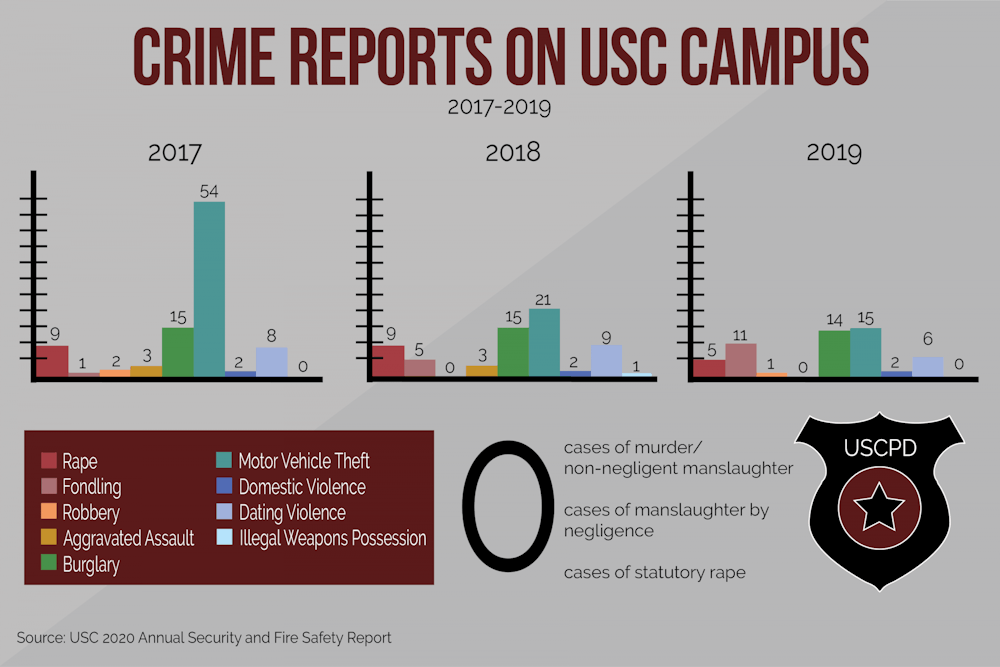The university has dealt with student deaths, druggings in Five Points and alcohol misuse over the past four years, and it is initiating programs to combat these safety issues among students.
Such responses came after the murder of Samantha Josephson in 2019. The incident sparked an international campaign initiated by President Emeritus Harris Pastides called "What's My Name?" aimed at promoting rideshare safety.
"Not only did it change the ways we look at ride-sharing, and ride-share safety on campus, but it changed how Uber, at least, looked at safety nationwide," USCPD Police Captain Eric Grabski said.
Sam Laundon, a 19-year-old USC student, died as a result of complications from blunt force trauma after he fell into the Vulcan Materials Company quarry in October 2020. Laundon's death was a "very, very tragic thing," Grabski said.
Since August 2017, there have been three reported student deaths related to issues of safety. The university has a trauma response team for student deaths, according to Marc Shook, the dean of students and deputy Title IX coordinator.
During the fall 2020 semester, there were shootings at student apartment complexes Rivers Edge and Granby Mills. Because these incidents occurred off-campus, USCPD cannot begin the investigation, but it can assist local law enforcement when shootings involve USC students, according to Grabski.
In October, Zachary Williams, a former student at USC, robbed and fatally shot 26-year-old Wesley Brown. Brown was shot at the 1700 block of Senate Street near the McMaster School of Visual Art and Design.
USC did not issue a Carolina Alert when this event occurred. University spokesperson Jeff Stensland told The Daily Gamecock Carolina Alerts are not required in situations that have "already occurred, and that we don't believe is currently a risk."
Christian Stegmaier, a local attorney at Collins & Lacy, told The Daily Gamecock he believes the university violated the Clergy Act by not issuing a Carolina Alert.
According to Grabski, USCPD has a close relationship with local law enforcement and the student apartment complexes to promote safety in these areas.
Grabski said he attributes a decrease in the crime rate on campus to the Rave Guardian app because students often report incidents through the texting feature in the app. Rave Guardian has been the primary venue for students to report druggings in Five Points.
USCPD received 84 emergency calls through the Rave Guardian app in 2019, and 45 calls in 2020. In 2019, 5,043 students registered for the app, while 1,707 students registered for the app in 2020.
"The way we handle [druggings in Five Points] is we assist in investigation with our partner law enforcement agencies with anything that we can help with. We have also been doing a lot of safety education about how to protect yourself — how to keep you and your drink safe," Grabski said.
Shook said his office works closely with the USCPD and helped handle the druggings in the fall.
"There was a specific meeting where we [sat] down with a large group that included our representatives from Student Health Services, particularly in our public health education," Shook said. "There was a campaign designed; we relaunched a number of our bystander intervention campaigns looking to educate students around those areas."
One of these bystander programs includes "Gamecocks Stand Up Bystander Intervention Training." According to the Combined Annual Security and Fire Safety Report, this program's scope covers "informational material, classroom discussion, and peer education."
Shook said he believes his office hugely impacts the reduction of alcohol misuse situations on campus. The number of hospital calls, which signify when a student has drunk so much they have to go to the hospital, has decreased significantly over the last four years, Shook said.
"While we've seen a decrease in that number, we're still not [to the point of no calls], we're still having students make poor choices. We have to be very diligent in our work to continue to encourage students to make good choices, particularly when it surrounds alcohol and other drugs," Shook said.
The Substance Abuse Prevention and Education office is the primary resource on campus for the prevention, education and early intervention for students who begin to misuse alcohol and drugs.
"We help people get connected to treatment programs if they need that and then we also have recovery support services," Aimee Hourigan, the director of the Substance Abuse Prevention and Education office, said. "We also do a lot of harm reduction education."
According to Hourigan and the AlcoholEdu executive summary from 2019-2020, 70% of USC students reported drinking less than five drinks when they go out.
USCPD has some new programs to promote campus safety for the 2021-2022 school year and plans to enhance many of its current programs, Grabski said.
"The one thing that we're continuing to enhance, as well, that you may or may not be aware of is, we have a council called the Community Relations Council," Grabski said. "We have a cross-section of different students and that group has been instrumental in helping us understand, number one, how we can connect better with our student population and also give great ideas on how to do that."

